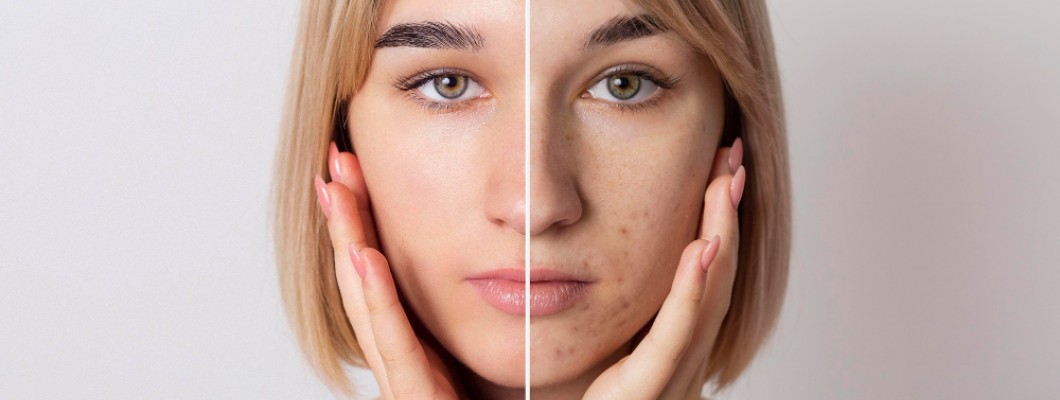
Homoeopathic medicine for acne
What's acne?
Acne can be described as a chronic skin condition that is characterised by the emergence of new types of eruptions.
What causes acne?
Acne is caused by the accumulation of oil and dead skin cells in hair follicles. Acne is more common in those with more oil glands. Acne is most common on the face, chest, back, shoulders, and buttocks. These areas are home to the highest number of sebaceous cells.
Causes and Treatments for Acne:
- Genetic tendency
- Age factor - Teenagers and young adults are easily affected.
- Diet - foods high in sugar and refined foods, as well as dairy products such milk, cheese, and other dairy products. Acne can be triggered or aggravated.
- Stress can make your condition worse
- Hormonal changes in pregnancy and puberty.
- Bacterial infection of hair follicles.
- Acne can also be triggered by certain medications.
- Pressure or friction on the skin
Acne may be any of the following:
- Whiteheads - These are pores that have been closed and plugged.
- Blackhead - Opened plugged pores
- Papule is a small, reddish, tender bump.
- Pustule is a painful condition that causes pustules.
- Cysts are painful, pus-filled lumps beneath the skin.
- Nodules are painful, large lumps that form under the skin.
Acne complications:
- Emotional distress is a common and easy-to-find problem in acne sufferers. People lose confidence in their skin, and eventually fall into depression and a pit of hating it.
- Scarring marks - Many times, acne can leave scarring marks on your skin that will not disappear easily.
Management of Acne:
- Be gentle to your skin.
- Wash the affected area at least two times per day. Dry the area with a towel and pat dry.
- Shampoo your scalp frequently if you have oily hair. This will prevent oil from seeping onto the skin.
- Get plenty of water.
- Exercise for at least half an hour each day.
- Avoid processed foods such as white sugar, chocolates and Maida.
- Foods rich in Omega-3 Fatty Acids such as flaxseed oil and cod liver oil should be included. Eat more fruits, vegetables, pulses and fish.
- If you are aware of the trigger factors, avoid them.
- Make sure you remove any makeup after using it.
Why does BNL Banoacne Drop?
Banoacne Drops is a great solution for treating all symptoms of acne. These drops can be used to relieve pain, itching, and other symptoms of acne.
Composition:
To treat all acne-related problems, the BNL Banoacne Drops have the following ingredients.
- Berberis Aquifolium is a wonderful treatment for skin conditions, particularly for dry, rough, and scaly skin. The scalp can develop into a rash that extends to the neck and face. This is a good treatment for dry eczema, psoriasis, and acne.
- Hydrocotyle Asiantica - the skin effects of this medicine can be very severe. Patients experience a variety of symptoms, including pustules on the chest, papules on their faces, skin irritations such as itching of the soles, tip, and vaginal areas, and irritable itching.
- Eugenia Jambolin is indicated for cases of mild and severe acne. Acne rosacea can lead to comedones and skin lesions. Painful pimples can be felt for some distance.
- Sepia Officinalis is a very effective treatment for skin conditions. The skin is very sensitive and itchy. The presence of blood boils and boils is common. The skin is yellowed and cracked, which can be further exacerbated by water.
- Thuja Occidentalis – A wonderful treatment for skin conditions. The skin is dark brown, spotted and hairy. Polyps, warts and eruptions are common. On the skin, eruptions are common. The smell of pustules is foul and the ulcers are usually flat. Brown spots on the arms and hands.
- Kalium Bromatum is a well-recommended medicine for cases of severe acne. The skin is dry and perspiration is blocked. All over the body, there are yellow and itchy spots. The skin feels extremely sensitive and itchy, especially when pressure is applied. Acne simplex, indurata, and large, indolent and painful pustules are all present.
- Calcarea Carbonica is one of the best anti-psoric medications. This medicine is great for patients with ulcerated skin or those who are otherwise in poor health. Itching and a burning sensation are common. Itchy, reddened skin and raised spots are signs of heat, thirst, and hunger. The skin is rough and dry as if it were covered in milia-like eruptions.
Dosage:
Adults can consume 20-30 drops mixed in half a cup of water three to four times per day. Children can take 15 to 20 drops mixed with half a cup of water three to four times per day.
Note: Each person needs a different dosage of medicine according to their symptoms. Therefore, it is important to consult a homoeopathic doctor before taking any medicine. To avoid future complications, it is best to not self-medicate.
